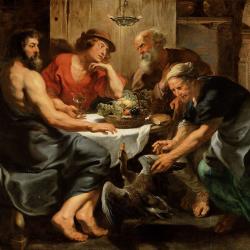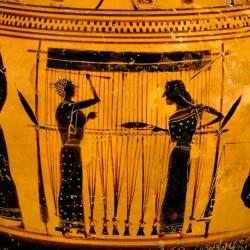You are here
Week 5
The theme for this week’s stories is Piety and the history topic is Greek architecture. In the lead story, Baukis & Philemon, the gods reward two old people for their hospitality and kindness. In Arachne, a talented weaver is punished for disrespecting Athena, goddess of weaving.
History materials
- Main topic
- Key ideas
- Making the link
- Teaching the topic
Greek architecture
The most visible legacy of the ancient Greeks can be identified in architecture. Although the classical style of architecture has reappeared in different forms in many different periods, the basic forms remain Greek and they can be identified in public, monumental and domestic buildings right up to the present day. Examples of buildings designed in the classical style can be seen throughout Europe and North America and in many other parts of the world, especially in those that were colonised or otherwise influenced by western powers.
Reverence for the gods
The Greeks believed that divinities were present throughout nature and watched over human activities. The failure to take account of this and to pay due respect to the gods endangered human well-being and happiness. Cities carried out religion on a large-scale, public level to secure the gods’ favour for the city as a whole, but rituals were also carried out on a family and individual level, both on a day-to-day basis and especially at crucial phases in life such as birth, acceptance into the family, coming of age, marriage and death.
Communication through architecture
Temples were so costly to build and decorate that they were always the result of public action on the part of the city-state. Individuals might visit temples for their own private purposes, but their primary role was in festivals and other large-scale acts of ritual that took place in the public space of a city or sanctuary. As such, temples and other public buildings were a means of conveying visibly the piety, wealth and power of the city-state.
The link with the main topic is made explicitly when the pious Baukis asks for their house to be turned into a golden temple.
The purpose of temples
You might begin with the drawing of a terracotta model of an early Greek temple or house — below. Remind the children that Baukis’ and Philemon’s house was turned into a golden temple. You could ask the children whether they think this model looks like a house. Draw their attention to the door flanked by columns and the gable roof; they will see how these develop in later temples.
This is a reconstruction drawing of a terracotta model found at the site of Perachora, dating from about 725-700 BC. Archaeologists are not certain whether it is a house or a temple, but are confident that early temples were similar. The first temples were built mainly of mudbrick and wood, probably with thatched roofs.
Why not read the Greek temples information sheet with the children? Discuss the idea of the temple as the home of the god and of the statue representing the god’s presence. You could use the children’s own knowledge to draw the distinction between most contemporary religious buildings as spaces for worship and Greek temples as houses of the gods. Remind them of the work you did in Week 3 on sacrifices and discuss how the smoke and mess of sacrifice might not be suitable for the inside of a building.
As the children look at the information sheet, try drawing their attention to the statue of Zeus in the picture — it should be familiar if they saw the statue of Olympian Zeus in Week 3. The original statue of Zeus at Olympia was made of gold and ivory. Its sculptor, Pheidias, also made a statue of Athena out of the same materials for the Parthenon in Athens. Look at the Nashville reconstruction of Athena’s statue and discuss the impact such statues would have on the visitors to the temples. If you have children who are members of faith communities, they might compare this with the experiences they have in their places of worship. You could bring out the difference between an individual’s engagement with the god and the large, public rituals they saw in Week 3.
Greek temples information sheet
A sheet for children with information about the nature and use of temples and drawings of the exterior and interior of the temple of Zeus at Olympia.
Nashville reconstruction of Athena
A reconstruction in Nashville of the gold and ivory statue of Athena that stood in the Parthenon. The original statue was about 12 metres tall. The image is zoomable to explore details.
The simple, early temple provides a good link to the more elaborate temples of the fifth and fourth centuries BC, examples of what we generally think of as Greek architecture.
Architecture
This excellent weblink provides accessible information for teachers about Greek architecture, images and resources, weblinks and ideas for teaching activities.
http://www.teachinghistory100.org/objects/for_the_classroom/greek_statue_of_a_woman
You might try looking back at the model of the early temple and recap the features the children identified. Then show the children some examples of later Greek temples. You could use the ones given below which are from different parts of the Greek world. Ask the children to describe the temples and what they have in common. The basic elements to bring out are the rectangular shape with columns all around, the gently pitched roof and the triangular space at the gable end — this is called the pediment. They may notice that there are walls and columns visible inside — these are the remains of the inner buildings which housed the statue of the god or goddess. They may also spot the two levels of horizontal frieze above the columns and the grooves carved in the columns. Ask the children to consider which of these parts owe their origins to the elements of the early temple they identified.
Temple F at Agrigento in Sicily
450-440 BC; called the Temple of Concord, it is not known which deity the temple was dedicated to; its excellent condition is due to its conversion to a Christian church in the AD 500s.
447-432 BC; built when Athens was at the height of its imperial power, the temple was a statement of the city’s devotion to its patron goddess Athena.
Two temples at Paestum in southern Italy
The far temple to Hera was built 550 – 520 BC; the near temple, either to Zeus or to Hera, was built between about 475 and 450 BC.
The Greeks’ use of stone for temples was probably influenced by their increased contact with cultures such as that of Egypt where there was a long tradition of building in stone. The first stone temples appear in Greece in the early 500s BC. You could discuss with the children the advantages and challenges of building in stone. Bring out the increased cost, the difficulty of working stone, the number of workers required.
The temples above are all in what is called the Doric style or order. The tops (capitals) of the columns are the easiest way to recognise the order. Look at the photo of a Doric capital below and then compare it with that of the Ionic capital. Try using the Build a temple challenge either as a whole class or in groups to design temples in the different orders.
An interactive game that involves making decisions about the design and scale of a temple for the goddess Athena.
Architecture as communication
Considering how complicated and expensive it must have been to construct temples, you could explain to the children that the resources to build them often came from city-states. Try asking the children why a city-state might want to build a temple, bringing out both the religious reasons and the opportunity a temple provided to impress rival city-states with wealth and power.
You might use the Temple decoration sheet to help the children understand how the sculptures on temples could communicate messages. The links below provide brief versions of the stories. Explain the stories briefly to the children and ask why they think these stories were used. The Pelops story may explain why chariot races featured on the programme of events at Olympia, but it also provides a strong warning against cheating. The story of Athena and Poseidon adds to the way in which the Parthenon honours the goddess on behalf of the city, but was also a reminder to everyone viewing the temple, Athenians and foreign visitors alike, that the city was under the protection of the goddess.
An information sheet for children showing reconstructions of parts of the decoration on two important temples and providing information about the myths they depict.
A brief version of the story of the contest between Athena and Poseidon for the status of patron deity of the city of Athens.
A brief version of the story of the chariot race near Olympia between Pelops and Oinomaos that resulted in the curse of Pelops.
You could use examples of later buildings to show the children how Greek architectural styles have survived. In each case, ask the children what they recognise as Greek. Why do they think the architects used this style for these particular buildings? What do they think is being communicated through the buildings?
London; built 1823-52
Washington DC; built 1836-42
Berlin; built in the 1780s as a monument to peace and to the high culture of the city of Berlin; it is now a symbol of freedom and the reunification of Germany.
Thiruvanathapuram, India; built 1931
Nairobi, Kenya; opened 1934
Palace of the Courts of Justice
Santiago, Chile; built in two stages 1905-1930
Athenaeum and Mechanics Institute
Oamaru, New Zealand; 1882; now a museum, formerly a library and education institute
Greek architectural influence is seen not only in grand buildings, but also in the details of doors, windows and roofs of houses and shops, in particular those built in the 1700s and 1800s. Examples can be found in most towns and cities in Britain. You could use the photos below to prepare the children for what to look for, then take them on a walk in a suitable part of town to see what they can spot.
Houses on Upper Parliament Street, Liverpool; probably 1820s
East End of London, 1893; note also the doorway on the right
Pirbright Institute, centre for research into viral diseases; Surrey; opened 2017
Continuing theme: Gods and goddesses
There are no new divinities to add to the children’s chart, but the stories provide further perspectives on the behaviour of Zeus and Hermes in the lead story and Athena in Arachne.
So far in the stories, Zeus has been a fearsome and somewhat distant deity; here, he shows his significance in the day to day conduct of humans. The distribution of justice is an important aspect of the role of Zeus. He acts harshly in Baukis & Philemon, but the reasons for his actions are more explicitly justified by the lack of respect shown by the villagers. In his treatment of the old couple he demonstrates that he will also reward piety.
In Arachne, Athena is seen in her role as goddess of skills and crafts. She is often perceived as quite a benevolent goddess, so it can be surprising to see her act cruelly in this story, but it is worth helping the children appreciate the disrespect shown by Arachne.
In both stories the gods and goddess disguise themselves among humans. This is, of course, so that they are not recognised and reinforces good behaviour — you can never be sure if you are dealing with a god in disguise. But disguise is also the only way in which gods can appear to ordinary humans; if they appeared as their true selves, they would be too dazzling for humans to bear.

